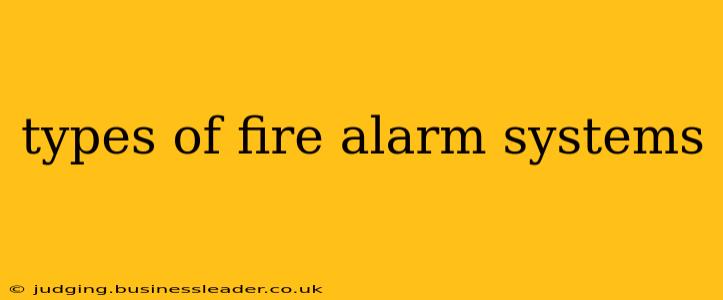Fire safety is paramount, and understanding the different types of fire alarm systems is crucial for protecting lives and property. Choosing the right system depends on factors like building size, occupancy, and local fire codes. This comprehensive guide explores the various types available, highlighting their features and applications.
What are the Different Types of Fire Alarm Systems?
Fire alarm systems are broadly categorized into several types, each with its own strengths and weaknesses. The most common types include:
-
Conventional Fire Alarm Systems: These systems utilize a single circuit to connect all detectors and notification appliances. When a detector senses fire, it triggers an alarm signal across the entire circuit, indicating a fire but not precisely where it's located. They are relatively simple and inexpensive, making them suitable for smaller buildings with less complex needs.
-
Addressable Fire Alarm Systems: Unlike conventional systems, addressable systems assign a unique address to each device. When a fire is detected, the control panel precisely identifies the location of the triggering device, providing crucial information for rapid response. This level of detail is invaluable in larger buildings or those with complex layouts.
-
Analog Addressable Fire Alarm Systems: These systems take addressable technology a step further. They transmit data beyond simple alarm signals, providing details like sensor sensitivity and battery status. This allows for proactive maintenance and early identification of potential issues, contributing to enhanced safety and system reliability.
What are the Components of a Fire Alarm System?
Understanding the components of a system is key to comprehending its overall functionality. Most fire alarm systems, regardless of type, include:
-
Smoke Detectors: These detect the presence of smoke, a common byproduct of combustion. Different types exist, such as photoelectric (responding to larger smoke particles) and ionization (responding to smaller smoke particles).
-
Heat Detectors: These detect an increase in temperature, indicating a fire’s presence. They come in various types, such as fixed temperature (triggering at a specific temperature) and rate-of-rise (detecting rapid temperature increases).
-
Flame Detectors: These detect the infrared or ultraviolet radiation emitted by flames, offering rapid detection of fast-developing fires.
-
Control Panel: The central unit of the system, receiving signals from detectors and initiating alarms. It also monitors system integrity and provides diagnostics.
-
Notification Appliances: These audible and/or visual devices (sirens, horns, strobes) alert occupants of a fire emergency.
What is the Difference Between a Conventional and an Addressable Fire Alarm System?
The primary difference lies in the system's ability to pinpoint the fire's location. Conventional systems offer a general alarm, while addressable systems precisely identify the triggering device, facilitating a quicker and more targeted response. Addressable systems are more complex and expensive but offer superior situational awareness in larger and more complex environments.
What Type of Fire Alarm System is Best for My Home?
For most residential applications, a conventional system with interconnected smoke detectors is generally sufficient and cost-effective. However, larger homes or those with multiple stories might benefit from an addressable system for improved location identification. Local fire codes should also guide the selection process.
How Much Does a Fire Alarm System Cost?
The cost varies significantly depending on the system type, complexity, and the number of detectors and devices. Simple conventional systems for small homes can be relatively inexpensive, while advanced addressable systems for large buildings can represent a substantial investment. Professional installation is highly recommended to ensure proper functionality and compliance with safety standards.
How Often Should I Test My Fire Alarm System?
Regular testing is crucial to ensure the system's reliability. Monthly testing of all detectors and notification appliances is recommended, along with annual professional inspection and maintenance. This proactive approach contributes to enhanced fire safety and peace of mind.
This guide offers a comprehensive overview of fire alarm systems. Remember to consult with a qualified fire protection professional to determine the optimal system for your specific needs and to ensure compliance with all applicable regulations. Your safety and the safety of others depend on it.
